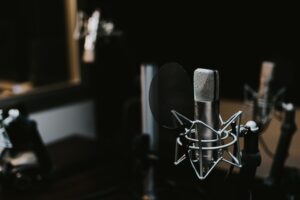If you’re kitting out a music studio, you want to make that from the get-go, you’re going about it in the right way.
Otherwise straight away you’re putting yourself at a major disadvantage; to be able to create the best sound, you need the best possible setup in terms of gear & studio space. They’re the foundations of any solid sound! Plus, with there being that many options out there, your chances of mastering your setup first time round right (without any prior research) are slim.
To build the perfect home studio you need a plan. Which is exactly why our music experts have taken the time to write this blog… to provide you with the basic blueprint you need to create a home studio which not only works for you acoustically, but is also kind to your back pocket.
Keep reading to discover the basic blueprint to building an impressive home studio…
What’s classed as ‘quality’ audio gear?
That’s a good question.
One that you need to be asking yourself before buying anything whatsoever. Because quality music gear doesn’t just come down to build quality. It’s about how well that kit enables you to produce; there’s little point investing mega bucks into a state-of-the-art studio setup if you’re not going to be able to get the best out of it.
Understand this, & you’re already ahead of 90% of producers, who end up just buying their kit based on a brand name or off the back of what other people have said. Quite a silly decision when you realise that other people likely don’t produce in the same way as you.
So if you want the real definition of quality music gear, it’s the gear that best resonates with you capabilities.
Exactly why when building your music studio, we’d advise you to…
- Not discount older gear – Not all good gear is new. In fact, for many producers, the best gear is traditional music gear, which they hook up to modern production via midi. Traditional synths are a popular choice amongst audiophiles, as are various pieces of rack gear. It’s commonly believed that you can achieve a better sound with this sort of gear, than you can with the plugin equivalents.
- Not assume price = quality – In this modern day & age, there’s actually not all that much in electronics anymore. A decade or so ago, cheap Chinese electronics were something to steer clear of. But now with production standards coming along so much in China, by writing off every piece of cheap gear, you may actually be shooting yourself in the foot. So be sure not to write-off brands like Donner & other cheaper manufacturers when making your decision.
- Push brand names to the back of your mind – As much as we all want to invest our funds in gear that’s built to last, you’d be wise to not focus on brand names when choosing your kit; don’t listen to YouTuber’s, listen to yourself & what you want out of your studio! Reason being that as much as brands may appear to be a big deal, there’s actually not a lot of difference. In many instances, music gear brands actually belong to the same parent company; Akai, Alesis & M-Audio for instance, are all owned by InMusic.
Audio gear every 21st century music producer MUST have…
Ever noticed how the term ‘music studio gear’ is incredibly broad?
That’s because it is, so when it comes to actually kitting your your music studio, it makes sense to have some form of shopping list. Otherwise you’re likely to forget to buy (or worse, not budget for) all the gear you need for your studio setup.
And while this list of requirements is going to differ depending on who you are as a producer, there are certain elements of kit that we think all prods should have; call them the studio necessities. In which case, here’s 5 pieces of studio gear that we believe all music producers need in their studio…
- Some form of midi controller – There’s no escaping the rise of digital production, so as a producer in any genre, you’re going to need some way of controlling midi. It’s here where a midi controller comes in. A controller that plugs directly into your computer & enables you to use virtual instruments to map sounds into your DAW. In most cases, these will come with a set of piano keys, although if that’s not how you produce, you can also get midi controllers with faders that get rid of the keys altogether.
- Accurate studio monitors for mixing – Any music producer who’s going to be mixing audio needs a quality set of studio monitors. There’s no doubt about it. Mixing is arguably one of the most pivotal parts of the production process – really think about it & it’s pretty much the finishing touch. So regardless of what music you produce or the size of your studio, a solid pair of reference monitors that allow you to mix the sound to a professional level, is a must. The Yamaha HS range are usually a good choice!

- A quality recording mic – Thanks to the internet, there’s more music producers than ever. All of whom are competing for the same artists that you want to work with. So an easy way for you to distinguish yourself would be to invest in all the vocal equipment you need (especially a good microphone) so you can invite artists into your studio to record. A major advantage, as most producers will require artists to hire out a third party studio, which for the artist = more costs in studio time. A perk that could easily persuade artists to leave other prods behind, & collab with you.
- Mic reflection filter/ pop shield + sound treatment – If you want to do any form of recording in your studio, then your room needs to benefit you in terms of acoustics. So aside from treating the walls & using soft furnishings to reduce reverb, you could also invest in a reflection filter like the Aston Halo, or a pop shield to diffuse unwanted plosives. Yet another form of studio gear that will save you acres of time editing vocals in post.
- A comfortable studio chair & desk setup – Yes, sound is the main focus of a music studio, but… what’s the point of having a studio, if you can’t use it for more than 10 minutes without chronic back pain? Exactly why investing a quality studio chair & desk combo, is arguably the most important (& underrated) part of creating a production space. After all, you not only want to be comfortable when making music, but also want to ensure that your gear is safe & close to hand.
Struggling for ideas & inspo? Here’s a peek inside a professional home studio…
In the case that all this talk of music studios & gear has got you wondering what a professional setup might look like (i.e. what to aim for), then you’re in luck.
Check out the video below to take a tour of a professional home studio setup…

